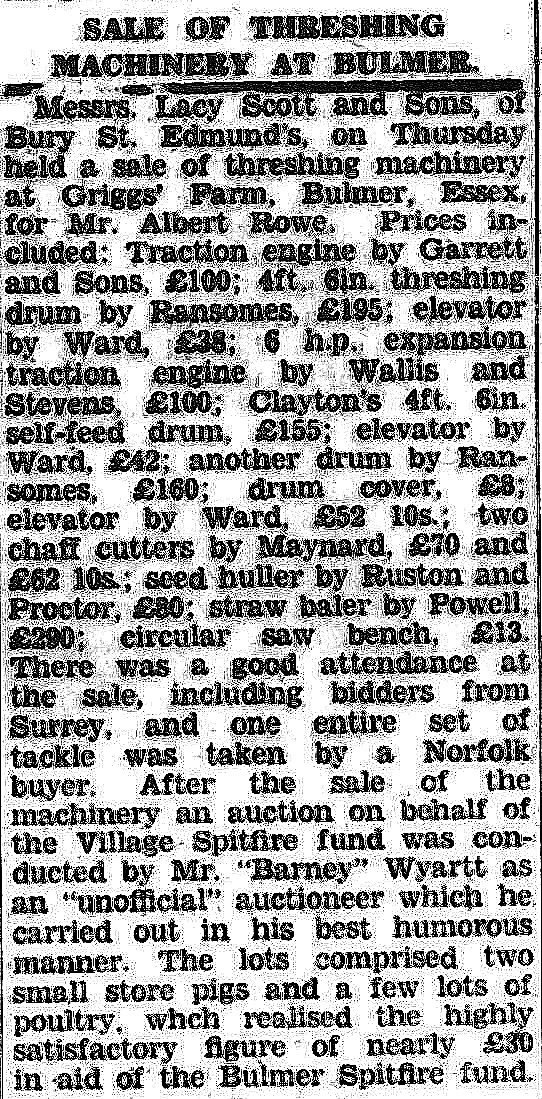Approaching Bulmer Street from the Gestingthorpe end, one of the first buildings you see on your left is the 17th Century Griggs Farmhouse, the lands were then farmed as part of Auberies estate. By the latter half of the 18th Century two farms, one north, the other south of The Street, were combined as Griggs and Swains owned by William Jennens of Suffolk. When he died in 1798, aged 98, he was reputed to have been the richest commoner in the country. His holdings close to two million pounds in value, were also Butlers, Black House, Jenkins, Kitchens and Tye Corner farms. Dickens’ novel “Bleak House” was said to have been based on the Jennens Case.
In the 19th Century William Bird farmed Griggs, then Charles Bird who farmed 280 acres with 12 men and 3 boys in 1871 and finally John Burlingham, a great supporter of the chapel.
At the turn of century came W. S. Courtnell who farmed it together with Kitchens. Tom Rowe recalls that in 1910, before tractors were generally in use, the chassis of an old motor vehicle was adapted for pulling a self-binder. The barn (now Suffolk Hall), dating from the same period as the house, has been converted into a dwelling.
Opposite Griggs are five houses erected on what was once a meadow known as Stackyard pasture, part of Swains Farm. Swains Cottage, built about 1902, replaced three earlier cottages on the site. From 1937-51 the Walkers lived there, a show-business family; Mr. Walker was a musician and acrobat and Mrs. Walker a singer. The two daughters were acrobats and performed with a third person as “The Three Garcias”. They appeared at the Palladium and other leading theatres. At various times they appeared with many well-known acts and personalities such as The Crazy Gang and Gracie Fields. In 1947 they appeared in a Royal Command Performance. Recently a house (Fylok) and a bungalow in the Roman style (Oatlands) have been built in the grounds of Swains Cottage. St Andrew's Rise, the latest of Bulmer’s ne
w housing developments, rises from here.
Sale at Griggs Farm for Albert Rowe and Collection for the Bulmer Spitfire Fund.
This is a most significant day in Bulmer’s History. The sale of a considerable amount of Albert Rowe’s threshing tackle. It is especially noteworthy, as Bulmer was known for its threshing contractors, and they played such an important role in local farming. It is slightly mysterious however. For it was not Albert Rowe’s final dispersal sale—or the end of his threshing business in Bulmer—as Peter Rowe remembers it continuing for another decade or so. One wonders if it was a clear out of some older machinery, as Albert moved towards using a tractor to drive the threshing machine?
Clearly however, it was a very significant sale, with attendees coming from as far away as Surrey to bid for the threshing and baling equipment, together with the two traction engines.
It is also interesting to see the reference to Barney Wyatt, a real character and livestock dealer from the mid-Suffolk / Hadleigh area. In addition to having a ‘larger than life personality’, he also had an enormous pocket watch. The latter was included in a photograph in a national newspaper, of a farmer’s protest march in London, in the 1930’s.
Perhaps the most interesting snippet, is the reference to the Bulmer Spitfire Fund.
The following is an extract from Ashley Cooper's book ‘Heart of Our History.’*
“As the war continued a new challenge emerged. It was the raising of funds. By October 1940 a collection had been started in many villages towards the cost of buying a Spitfire. Similarly, in 1941, "neighbouring Gestingthorpe formed a sub-committee, to co-operate in the national `War Weapons Week'."
Every village was similarly involved. In 1942 Sudbury and Melford District designated February 21st-28th as ‘WARSHIPS WEEK’
A target of SEVENTY FIVE THOUSAND POUNDS was set—being the amount required for the warship Scarab.
Yet, incredibly, "by Wednesday February 25th," reported The Suffolk Free Press, "the indicator outside the Town Hall had moved up to... £142,537 14s. 0d."
Of this:
Sudbury Borough had raised ...............£49,788 4s 0d
Acton..........................................................£3,151 6s 0d
Alpheton .................................................£3,817 18s 0d
Assington ..................................................£3,225 7s 0d
Bures ....................................................... ..£2,380 4s 6d
Chilton ......................................................£2,219 5s 0d
Gt. Cornard ............................................£19,528 7s 6d
Long Melford ......................................£10,579 11s 6d
Nayland with Wissington ......................£2,313 1s 6d
Newton .....................................................£3,284 5s 0d
Shimpling ...............................................£3,906 13s 0d
Stansted .................................................£3,678 16s 0d
Stoke by Nayland ....................................£2,515 9s 6d
Gt. Waldingfield ....................................£6,954 13s 0d
Glemsford ............................................. £10,141 7s 0d
The totals raised in Bulmer during the War, are currently unknown. If you would like to research this fascinating subject—or have any further details—please contact Bulmer History Group at info.bulmerhistory@gmail.com
*Heart of our History can be obtained at The Tourist Information Bureau, in Sudbury.


